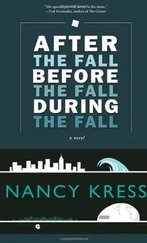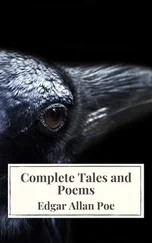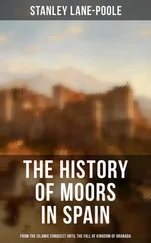39
Four and a half centuries before the mistakes made during Tito’s birth, therefore, Tommaso Rangone had already linked the name of the Scuola Grande di San Marco with the very worst of medical frauds.
40
How Man Can Live for More than 120 Years was dedicated to Pope Julius III. In his dedication, Tommaso Rangone predicted that the Pope would live a long life. This prediction, as Giacomo Leopardi noted ironically, proved false. Julius III died five years later, at the age of sixty-seven.
41
Giacomo Leopardi alluded to Tommaso Rangone in one of his Operette morali (Small Moral Works), entitled “Dialogue Between a Natural Philosopher and a Metaphysician.”
PHYSICIAN: Eureka! Eureka!
METAPHYSICIAN: What’s happened? What is this discovery you’ve made?
PHYSICIAN: The art of living for a long time …
I will live for all eternity; I will enjoy immortal glory .
42
By promising to help his patients live until they were one hundred and twenty, Tommaso Rangone amassed a great fortune. He used that great fortune to try to gain eternal life and immortal glory, just like the character in Giacomo Leopardi’s dialogue.
Tommaso Rangone discovered — “Eureka! Eureka!” — that the best way of gaining eternal life and immortal glory was to have artists reproduce his image in eternal, immortal works.
He paid for Jacopo Sansovino to adorn the door of the church of San Giuliano or San Zulian with his statue. He paid for Alessandro Vittoria to sculpt his bust for the church of San Geminiano. He paid for Jacopo Tintoretto to feature him in the four paintings commissioned to decorate the chapter house of the Scuola Grande di San Marco.
43
In the first painting, The Miracle of St. Mark Freeing the Slave , from 1548, Tintoretto portrayed Tommaso Rangone as a mere witness to the miraculous event, and showed him standing modestly on the left-hand side of the canvas.
In the other paintings, however, commissioned fourteen years later, for eighty ducats each, Jacopo Tintoretto broke all the rules of the age and portrayed Tommaso Rangone as an actual participant in the miracles of St. Mark.
In St. Mark Saving a Saracen from Shipwreck , Tommaso Rangone — like a hero from Xbox — goes back in time and is seen on board a boat, vigorously rowing, as he helps the Evangelist save the shipwreck victim from the stormy sea.
In The Rediscovery of the Body of St. Mark , Tommaso Rangone goes back in time and is shown kneeling in the cathedral, looking directly up at the saint’s soul.
In The Stealing of St. Mark’s Body , Tommaso Rangone goes back in time to Alexandria, and takes charge of the theft of the martyr’s body during a celestial storm.
44
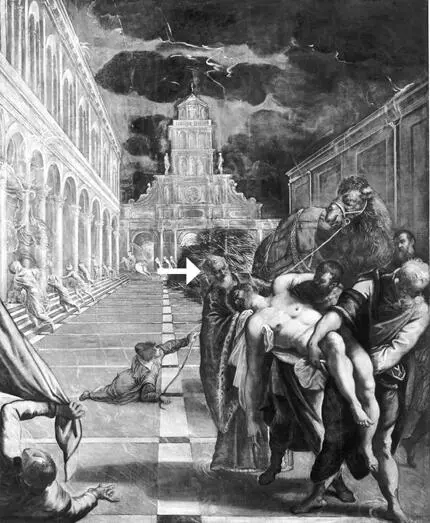
(Picture Credit 1.4)
45
In the previous image: The Stealing of St. Mark’s Body .
The painting is by Jacopo Tintoretto. It dates from 1562.
The arrow indicates the portrait of Tommaso Rangone.
46
In the paintings made by Jacopo Tintoretto for the Scuola Grande di San Marco, Tommaso Rangone was depicted as an aide to the miracle-working saint. This conferred on him the aura of an equally miracle-working doctor.
With his unique talent — and at a cost of eighty ducats per painting — Jacopo Tintoretto eternalized and immortalized medical charlatanism, personified by Tommaso Rangone and made matter in Tito’s birth, which took place in the same building four hundred and fifty years later.
An example of Pride of Art?
47
In The Stealing of St. Mark’s Body , a bearded man stands in the shadows to the right of the picture, next to the camel, watching the scene intently.
It is Jacopo Tintoretto himself.
He depicted himself as a spectator of the theft of the Evangelist’s body in exactly the same way in which Alfred Hitchcock appears in Vertigo , walking past a shipyard.
48
Vertigo .
When Tito walks, his muscles contract. When his muscles contract, he gets frightened. When he gets frightened, his muscles contract even more.
In Brazil, the title of Vertigo was translated as Um Corpo que Cai , “A Body Falling.” Tito is a body falling.
Each step taken by Tito is the same as a step taken by James Stewart up the bell tower of San Juan Bautista. All right, there’s no Alfred Hitchcock. There’s no Kim Novak either. There’s no Bernard Herrmann soundtrack. But everything else — as I said — is the same. The wide eyes. The open mouth. The dry tongue. The stiff legs. The sweat running down his back. The zoom in. The zoom out.
In the final scenes of Vertigo , James Stewart finally overcomes his fear of heights and climbs the bell tower of San Juan Bautista.
He says: “I made it.”
Tito, step by step, is making it too.
49
At the end of Vertigo , Kim Novak falls from the bell tower of San Juan Bautista. She falls and dies. James Stewart survives. Tito is James Stewart. He falls and survives.
To hell with Kim Novak.
50
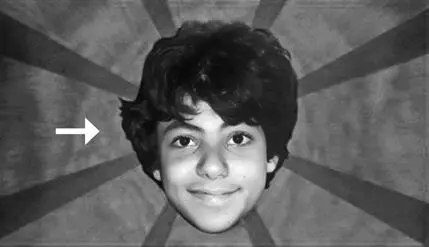
(Picture Credit 1.5)
51
In the previous image, Tito as James Stewart in Vertigo : wobbly, wild-eyed, surrounded by kaleidoscopic spirals, and with a green face.
52
Tito was green when he was born.
I saw him for the first time in one of the cloisters of Venice Hospital. I had just been talking to the pediatrician who had overseen his birth. He said that Tito had been deprived of oxygen for too long. He also said that Tito would die.
On my way back to the maternity ward, after talking to the pediatrician, I walked past a newborn baby in an incubator. The newborn baby in the incubator had been left in the cloister, parked in a corner. No one was looking after him. Where’s the doctor? Where’s the nurse? Where’s the father?
I glanced at him. I looked again. He wasn’t moving, his body was limp and he had a tube up his nose. I read the name written on the label stuck to the lid of the incubator: “Mingardi.”
Mingardi was me. I was Mingardi. The newborn baby in the incubator was my son. Mingardi was Mainardi. Venice Hospital even got his name wrong.
I looked at Tito one more time. His face was like mine — except that his was green.
53
Up until that moment, I had always thought that if my son were to fall into a vegetative state, I would prefer him to die.
After that first contact with Tito in the corridor of the cloister of Venice Hospital, everything changed. All I wanted was for him to survive, because I would always love him and help him in whatever way I could.
Caught between life and death, I clung to life.
54
Lying in the incubator, parked in a cloister in Venice Hospital, Tito, with his green face, was waiting for a boat to take him to the nearest neonatal intensive-care unit, in Padua Hospital.
55
In Padua Hospital, in 1739, George Macaulay graduated as an obstetrician. Some time later, he moved to London and, in 1756, in Brownlow Street Hospital, he became a pioneer in a surgical procedure known as an amniotomy.
A disastrous amniotomy two and a half centuries later sent Tito straight to the intensive-care unit in Padua Hospital.
Читать дальше





